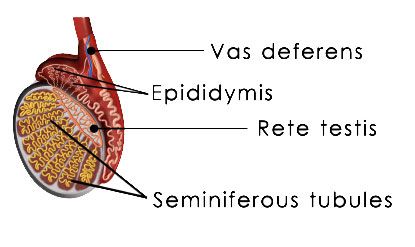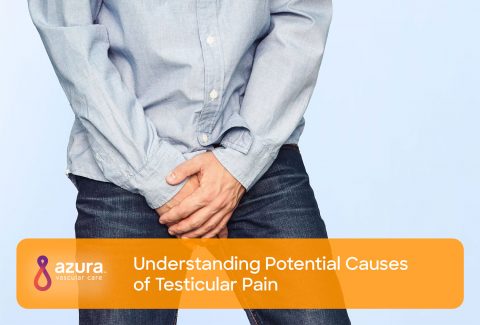
At some point in life, many men experience pain or discomfort in either one or both testicles. It might be caused by a direct injury, or it may appear out of the blue. The level of discomfort can be described in many ways and can last for varying amounts of time. Some men describe the feeling as a sore testicle, or testicular pain, or they may simply feel a dull pain. With left testicle pain, sometimes it’s the location of the pain that can help determine the cause.
 A common cause of testicular discomfort is a very treatable condition known as varicocele. It’s estimated that 15% of all men have varicocele, which is a collection of veins similar to varicose veins in the scrotum.[i] Because of the anatomical structure of the veins of the scrotum varicocele usually occurs on the left side. Only a doctor can diagnose you with varicocele, so if you’re experiencing testicular soreness, pain, or discomfort, stay calm and make an appointment with a doctor for evaluation.
A common cause of testicular discomfort is a very treatable condition known as varicocele. It’s estimated that 15% of all men have varicocele, which is a collection of veins similar to varicose veins in the scrotum.[i] Because of the anatomical structure of the veins of the scrotum varicocele usually occurs on the left side. Only a doctor can diagnose you with varicocele, so if you’re experiencing testicular soreness, pain, or discomfort, stay calm and make an appointment with a doctor for evaluation.
Pain and discomfort can be very hard to explain. Not everyone is going to experience and describe a condition in the same way. However, often there are certain words used to express how a specific condition feels, and these can be a clue to the cause. Before we get into different descriptions of pain or discomfort, it is important to know a little about the anatomy of the scrotum.
Anatomy of the Scrotum
 The testicles make up the vast majority of the scrotum, along with the epididymis, which sits on and behind the testicle. A tube called the vas deferens runs from the epididymis up from the scrotum and into the body. This tube carries the sperm. Also surrounding this tube are the arteries and veins that carry the blood to and from the testicle. These are the veins that are affected when men have varicocele. Sensations of pain coming from the scrotum can originate in the testicle or the epididymis, and it can be hard to distinguish the exact source without the guidance of your doctor.
The testicles make up the vast majority of the scrotum, along with the epididymis, which sits on and behind the testicle. A tube called the vas deferens runs from the epididymis up from the scrotum and into the body. This tube carries the sperm. Also surrounding this tube are the arteries and veins that carry the blood to and from the testicle. These are the veins that are affected when men have varicocele. Sensations of pain coming from the scrotum can originate in the testicle or the epididymis, and it can be hard to distinguish the exact source without the guidance of your doctor.
Understanding the Difference Between Sore Testicle, Pain in Testicle & Testicular Discomfort
The feeling described as soreness in a testicle usually happens gradually. If it’s one-sided and keeps increasing, or if you experience swelling and tenderness, it may be due to epididymitis. In sexually active men, the inflammation of the epididymis is commonly due to a sexually transmitted infection.[ii] Soreness also may be the term used to describe the sensation caused by varicocele. If you are experiencing soreness and are unsure of the cause it is important to consult with your primary physician to find out the cause so that proper treatment is provided.
RELATED: Help Me – Why Does My Testicle Hurt?
Testicular pain is usually a term reserved to describe a severe sensation of discomfort. Pain in the testicle that occurs suddenly can be due to a potentially serious condition known as testicular torsion. Testicular torsion involves the testicle twisting around its blood supply. This pain may be accompanied with nausea and the testicle may “ride high” in the scrotum. This is a medical emergency and if you’re experiencing a high degree of pain, you should be evaluated in an emergency department right away. Varicocele isn’t usually described as severely “painful,” like what men with testicular torsion experience. Occasionally, pain in the testicles is not related to the testicles at all, but is due to something known as referred pain. Referred pain is pain that is experienced in one area, but is actually due to nerve sensations triggered by another area of the body. For example, pain experienced from a kidney stone may not necessarily be felt in the actual kidney region.
RELATED: Why Does My Left Testicle Hurt and the Right One Doesn’t?
Discomfort is usually used to describe a dull, aching, or throbbing sensation. It may not be present all of the time. It may worsen after standing for long periods of time. Testicular discomfort is a good description of what men with varicocele may feel, however many men with varicocele are asymptomatic, feeling no pain or discomfort at all.[iii]. This same sensation of discomfort may also be present with post-vasectomy pain.
Only a physician can diagnose the cause of your testicular pain or discomfort. Remember, usually there are treatments for testicular conditions that can improve or reverse your symptoms. And, not all treatments are surgical. Minimally invasive, safe, and effective treatments are now available to treat some pain-causing testicular conditions. However, if you have severe pain, you should go to your local hospital’s emergency department for evaluation immediately.
Sources:
[i] Choi, W., and Kim, S., Current Issues in Varicocele Management: A Review. World J Mens Health, 2013. 31(1): p. 12-20.
[ii] Gordhan, C.G., Sadeghi-Nejad, H., Scrotal pain: Evaluation and management. Korean J Urol, 2015. 56: p. 3-11.
[iii] Mayo Clinic, Varicocele Symptoms. http://www.mayoclinic.org/diseases-conditions/varicocele/basics/symptoms/con-20024164


